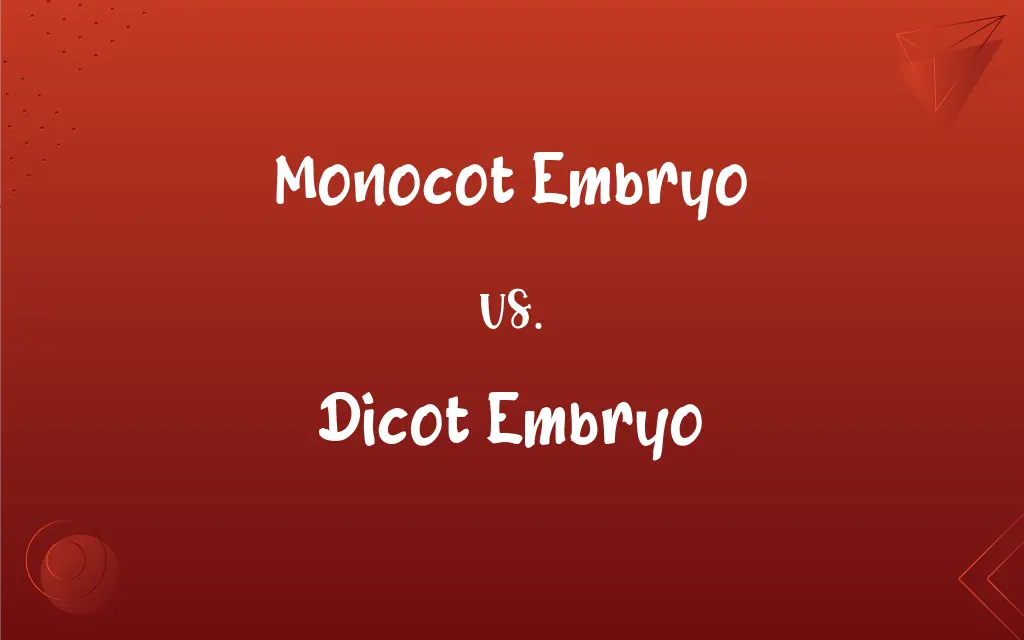Monocot Embryo vs. Dicot Embryo: What's the Difference?
Edited by Aimie Carlson || By Harlon Moss || Updated on October 28, 2023
A monocot embryo has one cotyledon (seed leaf), while a dicot embryo has two.

Key Differences
Monocot embryos and dicot embryos represent the initial developmental stages of monocotyledonous and dicotyledonous plants, respectively. One of the most distinguishing features between the two is the number of cotyledons or seed leaves they possess. A monocot embryo has a single cotyledon, which is primarily why it's termed "mono." Conversely, a dicot embryo has two cotyledons, hence the prefix "di" in its name.
Monocot embryos are found in plant species like grasses, lilies, and orchids. The single cotyledon present in these embryos is often elongated and plays a crucial role in the absorption of nutrients during germination. Dicot embryos, on the other hand, can be found in plants like beans, sunflowers, and roses. The paired cotyledons of dicot embryos often store food resources and expand during germination, offering a vital energy source for the sprouting seedling.
The structural organization of monocot and dicot embryos also varies in other ways. For instance, in monocot embryos, the vascular bundles in the stem are generally scattered, while in dicot embryos, they're typically arranged in a ring. Moreover, monocot embryos tend to have leaf veins that run parallel, while dicot embryos exhibit a more net-like venation in their leaves.
Beyond these embryonic differences, the mature plants that arise from monocot and dicot embryos also showcase several distinguishing characteristics. Monocot plants often produce flowers in multiples of three, whereas dicot plants commonly produce flowers in multiples of four or five. Additionally, the root development differs: monocot embryos give rise to a fibrous root system, while dicot embryos usually lead to the formation of a taproot system.
Comparison Chart
Number of Cotyledons
One
Two
ADVERTISEMENT
Common Examples
Grasses, lilies
Beans, sunflowers
Leaf Venation
Parallel
Net-like
Vascular Bundles in Stem
Scattered
Arranged in a ring
Root System Development
Typically gives rise to a fibrous root system
Typically leads to the formation of a taproot system
Monocot Embryo and Dicot Embryo Definitions
Monocot Embryo
Monocot embryos often lead to plants with parallel leaf venation.
The presence of a monocot embryo in a seed predicts the parallel venation in the mature plant's leaves.
ADVERTISEMENT
Dicot Embryo
Dicot embryos are typical of plants producing flowers in multiples of four or five.
Roses, emerging from a dicot embryo, typically present flowers with five petals.
Monocot Embryo
Monocot embryos are characteristic of plants producing flowers in multiples of three.
Lilies, having a monocot embryo, usually blossom with three-petaled flowers.
Dicot Embryo
A dicot embryo is the initial development phase of a dicotyledonous plant.
The bean seed houses a dicot embryo, evident from its two cotyledons.
Monocot Embryo
A monocot embryo is the initial growth stage of a monocotyledonous plant.
The grain of rice contains a monocot embryo with a single cotyledon.
Dicot Embryo
Dicot embryos often lead to plants with net-like leaf venation.
The presence of a dicot embryo in a seed indicates the netted pattern observed in the mature plant's leaves.
Monocot Embryo
Monocot embryos possess a single seed leaf or cotyledon.
Within the maize seed, the monocot embryo showcases one distinct cotyledon.
Dicot Embryo
Dicot embryos feature two distinct seed leaves or cotyledons.
Upon dissecting a sunflower seed, the dicot embryo reveals a pair of cotyledons.
Monocot Embryo
Monocot embryos typically give rise to a fibrous root system.
The grass, sprouting from a monocot embryo, develops a dense network of fibrous roots.
Dicot Embryo
Dicot embryos usually result in plants with a taproot system.
The oak, originating from a dicot embryo, grows a sturdy taproot anchoring it to the ground.
FAQs
What is a monocot embryo?
A monocot embryo is the initial growth stage of a monocotyledonous plant and has one cotyledon.
Are the leaf veins in monocot and dicot embryos different?
Yes, monocot embryos lead to leaves with parallel venation, while dicot embryos result in leaves with net-like venation.
How many cotyledons does a dicot embryo possess?
A dicot embryo has two cotyledons.
Which type of embryo, monocot or dicot, is found in beans?
Beans contain a dicot embryo.
Do the seeds of all flowering plants contain either a monocot or dicot embryo?
Yes, most angiosperms (flowering plants) can be classified as having either a monocot or dicot embryo.
Are the flowers of plants coming from monocot embryos different from those of dicot embryos?
Yes, monocot plants often have flowers in multiples of three, while dicot plants usually have flowers in multiples of four or five.
How do the cotyledons of a dicot embryo function during germination?
In dicot embryos, the cotyledons often store nutrients and provide energy for the sprouting seedling.
Do monocot and dicot embryos differ in their germination process?
While the basic germination process is similar, there are differences in how the cotyledons behave and appear during germination.
Which type of embryo is present in lilies?
Lilies contain a monocot embryo.
Why is the distinction between monocot and dicot embryos taught in basic botany?
Understanding the difference helps in plant identification, understanding growth patterns, and provides foundational knowledge in plant biology.
Can you give an example of a plant that originates from a monocot embryo?
Grasses, like maize, originate from a monocot embryo.
What kind of root system do dicot embryos usually lead to?
Dicot embryos typically result in plants with a taproot system.
Are there any plants that don't fit neatly into the monocot or dicot embryo categories?
While the majority of plants can be classified as monocot or dicot, there are some exceptions and evolutionary intermediates.
Do monocot embryos have a specific pattern in their flower parts?
Yes, plants arising from monocot embryos typically produce flowers in multiples of three.
Which plants, coming from dicot embryos, are common in daily life?
Plants like beans, sunflowers, and roses arise from dicot embryos.
What's the significance of the number of cotyledons in embryos?
The number of cotyledons, one in monocot and two in dicot, plays a role in early nutrition and indicates various structural and developmental differences in the mature plant.
Which embryo type, monocot or dicot, leads to plants with a fibrous root system?
Monocot embryos usually lead to plants with a fibrous root system.
Can the type of embryo determine the plant's adaptability or resilience?
While the type of embryo gives insights into structural characteristics, other genetic and environmental factors play more significant roles in adaptability.
How are the vascular bundles arranged in plants arising from monocot embryos?
In plants arising from monocot embryos, the vascular bundles are generally scattered throughout the stem.
Is the distinction between monocot and dicot embryos crucial in botany?
Yes, the distinction helps in classifying plants, understanding their growth patterns, and predicting certain features of the mature plant.
About Author
Written by
Harlon MossHarlon is a seasoned quality moderator and accomplished content writer for Difference Wiki. An alumnus of the prestigious University of California, he earned his degree in Computer Science. Leveraging his academic background, Harlon brings a meticulous and informed perspective to his work, ensuring content accuracy and excellence.
Edited by
Aimie CarlsonAimie Carlson, holding a master's degree in English literature, is a fervent English language enthusiast. She lends her writing talents to Difference Wiki, a prominent website that specializes in comparisons, offering readers insightful analyses that both captivate and inform.































































